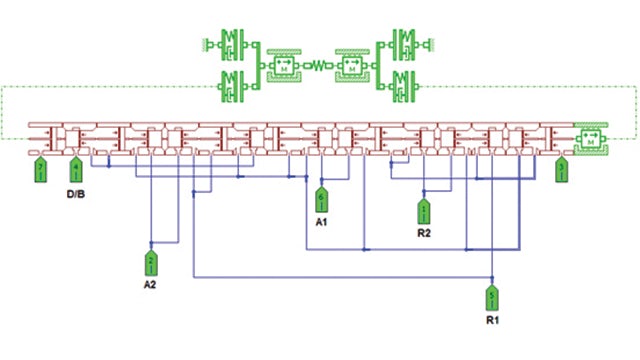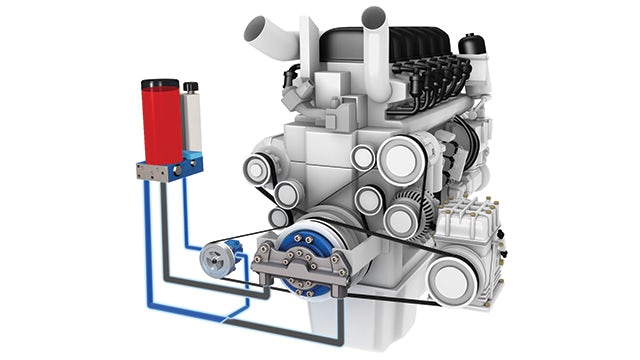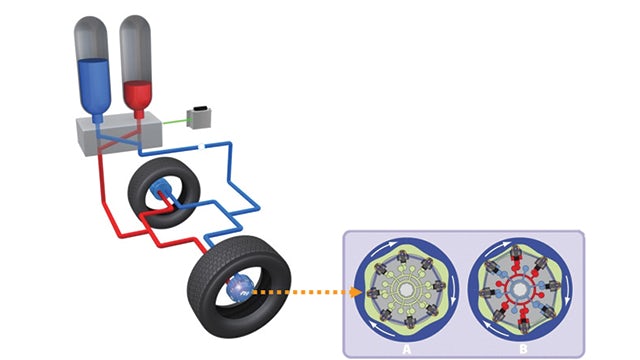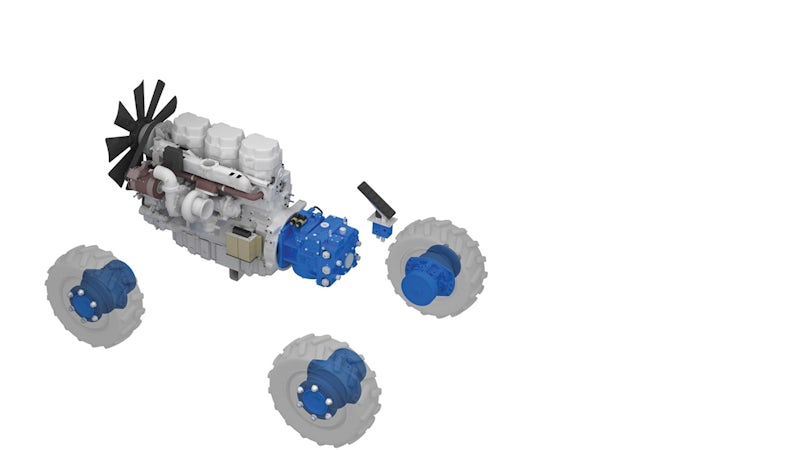Simulating system performance helps hydrostatic systems manufacturer lower fuel consumption, increase innovation and improve sustainability
The use of Simcenter Amesim enables Poclain Hydraulics to simulate transmission behavior, helping its engineers develop answers to given issues faster and at a lower cost.
Poclain Hydraulics
Poclain Hydraulics designs, manufactures and markets hydrostatic systems, such as transmissions, as well as associated services, for a wide range of heavy-duty vehicles used in construction, agriculture, industrial and transportation applications.
http://www.poclain-hydraulics.com- Headquarters:
- Verberie, France
- Products:
- Simcenter Products, Simcenter Amesim
- Industry Sector:
- Heavy equipment
Simcenter Amesim enables us to imagine new solutions because of a better understanding of the system. In particular, the simulation enables us to focus on variables that cannot even be measured, and test new concepts without the need for an expensive prototype. For vehicle simulation, even if we have a good knowledge of each component, the interaction between them is not always easy to evaluate
Poclain Hydraulics
Imagining new solutions through improved understanding
Poclain Hydraulics uses Simcenter Amesim software part of Simcenter portfolio, from Siemens Digital Industries Software, to help design robust hydrostatic systems, such as transmissions for use in heavy-duty vehicles. In recent years, automotive suppliers have shifted from providing components to providing complete systems to their original equipment manufacturer (OEM) customers. Poclain Hydraulics has also made that transition, implementing new competencies that enable them to perform simulation on the full transmission system of its customers’ vehicles.
The use of Simcenter Amesim enables Poclain Hydraulics to simulate transmission behavior, helping its engineers develop answers to given issues faster and at a lower cost.
“Simcenter Amesim enables us to imagine new solutions because of a better understanding of the system,” says Gilles Lemaire, Poclain Hydraulics’ scientific support manager. “In particular, the simulation enables us to focus on variables that cannot even be measured, and test new concepts without the need for an expensive prototype. For vehicle simulation, even if we have a good knowledge of each component, the interaction between them is not always easy to evaluate.”
Poclain Hydraulics chose Simcenter Amesim for this work because of the diversity of available libraries and the different levels of simulation provided, from detailed hydraulic components to hydraulic systems and complete vehicles. Another factor was the ability to address global system simulation with an explicit representation of components, such as pumps, motors, valves, etc.

Making a more efficient passenger bus
With a new vehicle such as a hybrid commercial passenger bus, Poclain Hydraulics initially strives to understand the effectiveness of an existing bus, taking into account the vehicle’s duty cycle, driver, and local traffic laws. The second phase is to study new solutions and analyze their efficiency, not only on the actual duty cycle, but also with respect to the robustness of the solution under different load cases.
The main issue for the bus project is how to store as much braking energy as possible and release this energy as efficiently as possible. To store the maximum amount of energy, the size of the system must be adequate for the requirements of the driver at any time during the duty cycle, under any condition of use. By grasping the efficiency of each component of the hydraulic system at any phase of use, the simulation enables global efficiency for the energy release. This is not easily measured on an actual vehicle, but can be readily simulated on computers.
The main contribution of the simulation is to analyze the impact of the system on the fuel consumption of the vehicle, as affected by the main mechanical transmission and the engine. For example, by decreasing the power demand on the engine during restitution phases, the impact on its efficiency was not always positive.
“Using the simulation capabilities of Simcenter Amesim, we were able to estimate the best way to release the stored energy by improving the control of the hydraulic mechanical systems,” says Lemaire. “We also particularly focused on the way the gearbox is controlled during braking to make all of the systems work together. This provides the best experience for the driver, and maximizes energy regeneration.”
From this analysis, Poclain Hydraulics engineers adapt new components with better efficiencies while choosing the right size of components, keeping in mind the results for various duty cycles. “We end up with a good knowledge of the application, a good understanding of its functionality, and important clues for its improvement,” notes Lemaire. “At a higher level, this experience enables us to analyze a new application, such as ‘duty cycle plus vehicle,’ to predict potential energy regeneration solutions.”
“At the same time, we take advantage of the different level of details offered by Simcenter Amesim in order to investigate transient phases,” says Yohann Brunel, advanced studies engineer at Poclain Hydraulics. ”We are able to study behavior, such as engagement and disengagement of the motors from a complete representation of each motor piston, in order to synchronize them with the wheel speed.”

Defining different levels of control
To make everything work together without conflicts or instability, Poclain Hydraulics needed to define different levels of control. The higher level of control helps ensure energy management by splitting power between both systems, while the intermediate level helps ensure each subsystem will provide the required power every time. The lower level manages the functional limitations of the systems. All of the basic controls were made by importing the signal and control library directly from Simcenter Amesim.
To improve the system, such as choosing the best components and the best way to control them, the analysis consists of observing the energy that transits into the system during deceleration and acceleration. This enables Poclain Hydraulics to track energy that is lost or cannot be recovered. The main criteria are the fuel consumption on a given duty cycle and the return on investment (ROI). Brake wear can also be studied with this analysis.
“The online strategy is validated through Simcenter Amesim,” says Brunel. “The main difficulty is to find a robust strategy, whatever the duty cycle. The strategy may also have to be adapted when the size of the system is modified.

Achieving high-value solutions
Model-based system engineering is an exceptional way to decrease development costs on existing concepts and to enable more innovative ideas, as is the case at Poclain Hydraulics. It also enables people to work together more effectively, from the component designer to the system designer to the control software programmer.
According to Brunel, the model-based system engineering approach is also an excellent way to work collaboratively with customers. “The degree of collaboration varies,” he says. “Some customers state their precise specifications and ask Poclain Hydraulics for the right component to handle their needs. The company’s expertise in machine constraints and use of Simcenter Amesim are critical factors in its ability to deliver complete, high-value solutions, as is its knowledge of sustainable systems.” Among its solutions for sustainable mobility, Poclain Hydraulics’ truck assistance solution AddiDrive™ Assist and hybrid system CleanStart™ are already on the market, and take advantage of the company’s capability to design dedicated systems for its customers.
“Sustainability is becoming more and more important to the market,” says Yannick Seeleuthner, Poclain Hydraulics’ group marketing manager. “This is not something new for Poclain Hydraulics, because it has always been one of our key values. Hydraulic transmissions have always been among the most energy efficient for mobile applications. Meanwhile, our products are 100 percent recyclable, and we are implementing solutions in our factories to further minimize our environmental footprint. Reducing fuel consumption for our customers’ machines is a key driver in our design process.”
“Using the simulation capabilities of Simcenter Amesim, we were able to estimate the best way to release the stored energy by improving the control of the hydraulic mechanical systems. We also particularly focused on the way the gearbox is controlled during braking to make all of the systems work together. This provides the best experience for the driver, and maximizes energy regeneration.
Poclain Hydraulics
